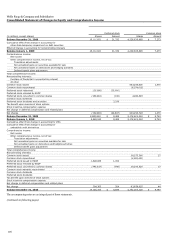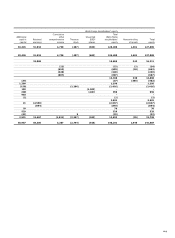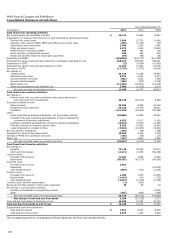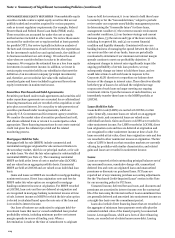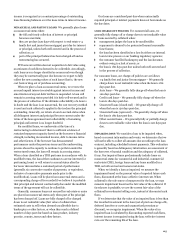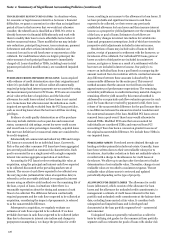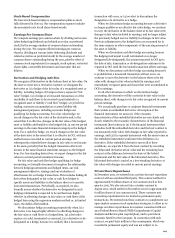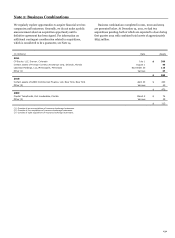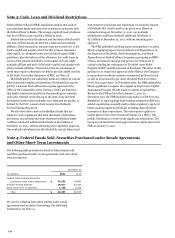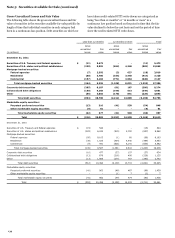Wells Fargo 2011 Annual Report Download - page 127
Download and view the complete annual report
Please find page 127 of the 2011 Wells Fargo annual report below. You can navigate through the pages in the report by either clicking on the pages listed below, or by using the keyword search tool below to find specific information within the annual report.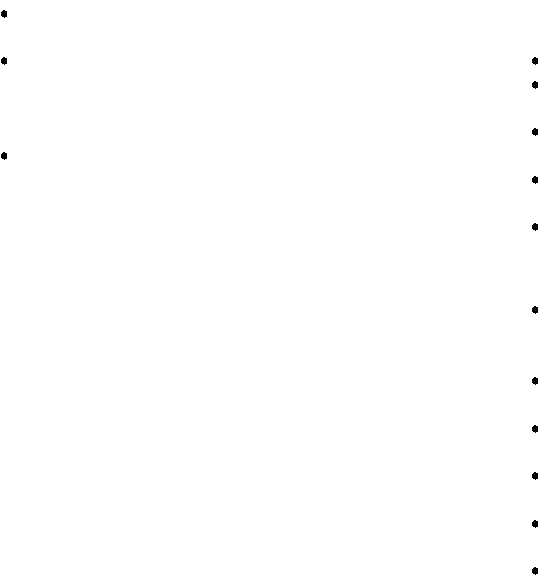
income is recognized as a constant percentage of outstanding
lease financing balances over the lease terms in interest income.
NONACCRUAL AND PAST DUE LOANS
We generally place loans
on nonaccrual status when:
the full and timely collection of interest or principal
becomes uncertain;
they are 90 days (120 days with respect to real estate 1-4
family first and junior lien mortgages) past due for interest
or principal, unless both well-secured and in the process of
collection; or
part of the principal balance has been charged off and no
restructuring has occurred.
PCI loans are written down at acquisition to fair value using
an estimate of cash flows deemed to be collectible. Accordingly,
such loans are no longer classified as nonaccrual even though
they may be contractually past due because we expect to fully
collect the new carrying values of such loans (that is, the new
cost basis arising out of purchase accounting).
When we place a loan on nonaccrual status, we reverse the
accrued unpaid interest receivable against interest income and
amortization of any net deferred fees is suspended. A loan will
remain in accruing status provided it is both well-secured and in
the process of collection. If the ultimate collectability of a loan is
in doubt and the loan is on nonaccrual, the cost recovery method
is used and cash collected is applied to first reduce the principal
outstanding. Generally, we return a loan to accrual status when
all delinquent interest and principal become current under the
terms of the loan agreement and collectability of remaining
principal and interest is no longer doubtful.
For modified loans, we underwrite at the time of a
restructuring to determine if there is sufficient evidence of
sustained repayment capacity based on the borrower’s financial
strength, including documented income, debt to income ratios
and other factors. If the borrower has demonstrated
performance under the previous terms and the underwriting
process shows the capacity to continue to perform under the
restructured terms, the loan will remain in accruing status.
When a loan classified as a TDR performs in accordance with its
modified terms, the loan either continues to accrue interest (for
performing loans) or will return to accrual status after the
borrower demonstrates a sustained period of performance
(generally six consecutive months of payments, or equivalent,
inclusive of consecutive payments made prior to the
modification). Loans will be placed on nonaccrual status and a
corresponding charge-off is recorded if we believe it is probable
that principal and interest contractually due under the modified
terms of the agreement will not be collectible.
Generally, consumer loans not secured by real estate or autos
are placed on nonaccrual status only when part of the principal
has been charged off. Loans are fully charged off or charged
down to net realizable value (fair value of collateral less
estimated costs to sell) when deemed uncollectible due to
bankruptcy or other factors, or when they reach a defined
number of days past due based on loan product, industry
practice, country, terms and other factors.
Our loans are considered past due when contractually
required principal or interest payments have not been made on
the due dates.
LOAN CHARGE-OFF POLICIES
For commercial loans, we
generally fully charge off or charge down to net realizable value
for loans secured by collateral when:
management judges the loan to be uncollectible;
repayment is deemed to be protracted beyond reasonable
time frames;
the loan has been classified as a loss by either our internal
loan review process or our banking regulatory agencies;
the customer has filed bankruptcy and the loss becomes
evident owing to a lack of assets; or
the loan is 180 days past due unless both well-secured and
in the process of collection.
For consumer loans, our charge-off policies are as follows:
1-4 family first and junior lien mortgages – We generally
charge down to net realizable value when the loan is 180
days past due.
Auto loans – We generally fully charge off when the loan is
120 days past due.
Credit card loans – We generally fully charge off when the
loan is 180 days past due.
Unsecured loans (closed end) – We generally charge off
when the loan is 120 days past due.
Unsecured loans (open end) – We generally charge off when
the loan is 180 days past due.
Other secured loans – We generally fully or partially charge
down to net realizable value when the loan is 120 days past
due.
IMPAIRED LOANS
We consider a loan to be impaired when,
based on current information and events, we determine that we
will not be able to collect all amounts due according to the loan
contract, including scheduled interest payments. This evaluation
is generally based on delinquency information, an assessment of
the borrower’s financial condition and the adequacy of collateral,
if any. Our impaired loans predominantly include loans on
nonaccrual status for commercial and industrial, commercial
real estate (CRE), foreign loans and any loans modified in a
TDR, on both accrual and nonaccrual status.
When we identify a loan as impaired, we measure the
impairment based on the present value of expected future cash
flows, discounted at the loan’s effective interest rate. When
collateral is the sole source of repayment for the loan, we may
measure impairment based on the fair value of the collateral. If
foreclosure is probable, we use the current fair value of the
collateral less estimated selling costs, instead of discounted cash
flows.
If we determine that the value of an impaired loan is less than
the recorded investment in the loan (net of previous charge-offs,
deferred loan fees or costs and unamortized premium or
discount), we recognize impairment. When the value of an
impaired loan is calculated by discounting expected cash flows,
interest income is recognized using the loan’s effective interest
rate over the remaining life of the loan.
125



